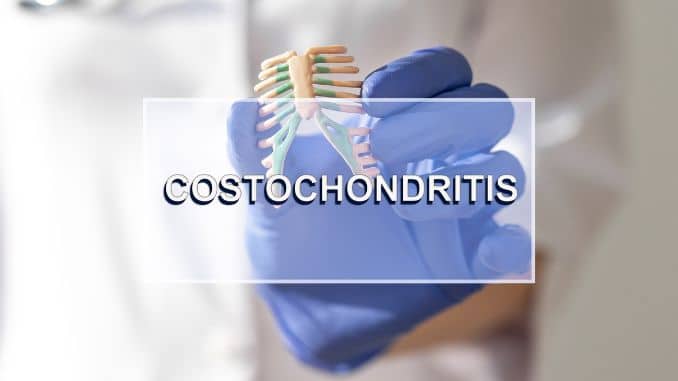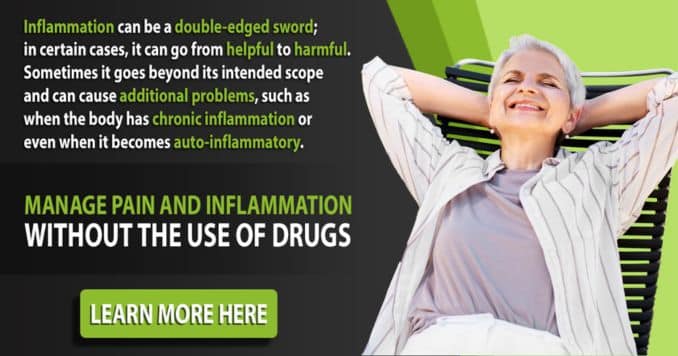Navigating the persistent challenges of costochondritis, characterized by intense pain and discomfort, can often seem like an endless struggle. However, there exists a path towards relief. This article takes us on a universal exploration from the hardships of managing costochondritis to the illumination of recovery. Join this journey to gain insights and unveil reliable approaches leading to healing. From confronting daily hurdles to uncovering effective treatment strategies, it's a tale of resilience, optimism, and conquering the grip of this incapacitating ailment.
Whether seeking reassurance in the possibility of recovery or practical advice, this is a space for collective empowerment, disclosing transformative steps from the overwhelming chronic pain of costochondritis to the joy of a pain-free existence.
Understanding Costochondritis
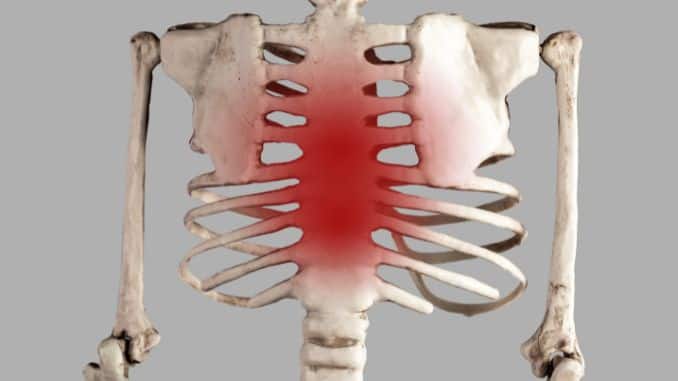
Costochondritis, also called chest wall pain, is a painful joint condition characterized by inflammation within the cartilage linking the ribs to the sternum. It has the potential to cause considerable discomfort, frequently confused with a heart attack due to the sharp chest pain it causes. While not life-threatening, costochondritis can severely impact the quality of life, making simple tasks like breathing, coughing, or even laughing excruciating. Understanding the nature of this condition is crucial in finding effective ways to manage and eventually overcome it.
Costochondritis Symptoms
Common symptoms of costochondritis include:
- Chest Pain: The most prominent symptom is a sharp or stabbing pain in the chest, typically on one side. This pain can be quite intense and is often mistaken for heart-related issues.
- Tenderness: The area where the ribs meet the breastbone (costosternal junction) may be tender to the touch. Pressing on this area can exacerbate the pain.
- Pain with Movement: Pain tends to worsen with certain movements, such as deep breathing, coughing, sneezing, or physical activities that involve the chest, like lifting heavy objects.
- Pain that Radiates: In some cases, the pain may radiate to the back or abdomen, making it even more challenging to differentiate from other conditions like heart problems or gastrointestinal issues.
- Muscle Pain: Some individuals may also experience muscle pain and discomfort in the chest wall, which can be associated with costochondritis.
- Swelling: While less common, mild swelling may occur in the affected area due to inflammation of the cartilage.
- Pain Relief with Rest: Symptoms typically improve with rest or by avoiding movements and activities that trigger the pain.
It's important to note that costochondritis is generally benign and not considered life-threatening. However, suppose you experience chest pain or discomfort. In that case, especially if it's severe or persistent, it's crucial to seek medical attention because it may be the pain signals a more serious condition, including ankylosing spondylitis and rheumatoid arthritis-related complications.
Additionally, your healthcare provider can diagnose costochondritis through a physical examination, and sometimes imaging tests like X-rays may be ordered to confirm the diagnosis and rule out other underlying issues. Treatment often includes pain management and anti-inflammatory measures, such as rest, over-the-counter pain relievers, and sometimes physical therapy, which can be particularly important if you have underlying rheumatoid arthritis that may contribute to inflammation in the chest area.
Is Costochondritis Dangerous?

Costochondritis itself is not dangerous, but the symptoms it presents can be distressing and affect daily functioning. It's important to differentiate between the pain caused by costochondritis and any pain worse than that of a heart attack, especially for individuals experiencing chest pain for the first time. Seeking medical attention to rule out cardiac issues is essential for proper diagnosis and peace of mind.
What Irritates Costochondritis?

Certain activities or postures, such as heavy lifting, sudden movements, or even deep breathing, can aggravate costochondritis pain. Stress and anxiety can also exacerbate symptoms, as the tension in the body can put additional strain on the chest area. Moreover, identifying triggers and making necessary adjustments to minimize discomfort is crucial to managing costochondritis.
Vitamins to Take for Costochondritis

Adding particular vitamins and supplements to your daily regimen can help minimize inflammation and support overall well-being in your chest health. Vitamin D, recognized for its contribution to bone health, has the potential to strengthen the skeletal structure, potentially alleviating some chest wall pain and discomfort associated with costochondritis. Additionally, omega-3 fatty acids possess anti-inflammatory properties that may offer advantages to individuals experiencing this condition.
How I Cured My Costochondritis Naturally?

When individuals grapple with the persistent pain of costochondritis, they often become determined to find natural remedies that provide relief without unwanted side effects. Costochondritis treatment, through extensive research and trial and error, many discover a combination of natural approaches that significantly contribute to pain medication and recovery. From dietary changes to alternative therapies, embracing a holistic approach to healing proves pivotal in transforming the experience with costochondritis.
How to Get Rid of Costochondritis Fast?
Moreover, the quest to alleviate the discomfort of costochondritis often leads to a search for quick solutions. While no magic bullet exists for instant relief, specific strategies can help ease the symptoms and promote healing. Additionally, applying ice packs to the affected area can reduce inflammation and numb the pain, providing temporary respite. Over-the-counter nonsteroidal anti-inflammatory drugs medications can offer short-term relief, but it's essential to consult a healthcare professional before using them regularly.
Traditional Treatment Methods
In severe cases, healthcare providers may recommend traditional treatment methods to manage costochondritis. These can include prescription-strength anti-inflammatory medications, such as corticosteroids, to help reduce inflammation and relieve pain. Physical therapy might be recommended to enhance posture, strengthen chest muscles, and promote flexibility in the impacted region. Despite their efficacy, close monitoring is essential due to potential side effects.
Alternative Approaches and Therapies
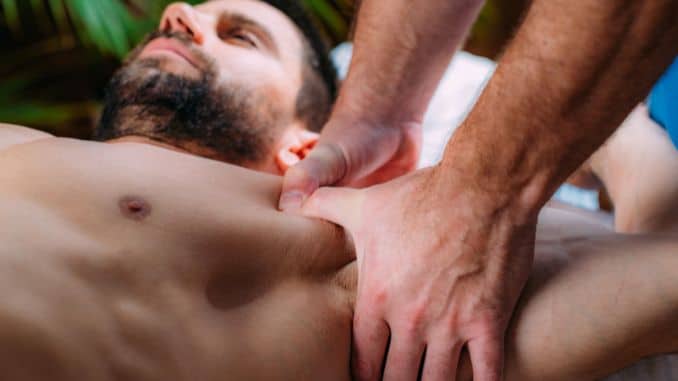
For those seeking alternatives to conventional medical treatments, various therapies and approaches have shown promise in managing costochondritis. Acupuncture, a practice rooted in traditional Chinese medicine, has been reported to provide relief by stimulating specific points in the body, promoting better energy flow, and reducing pain.
Additionally, chiropractic adjustments, massage therapy, and transcutaneous electrical nerve stimulation (TENS) have been found to offer comfort and aid in restoring proper alignment and function in the chest area. TENS therapy specifically utilizes a compact device to administer mild electrical pulses to the afflicted region, directly addressing nerve pathways to relieve discomfort. These alternative treatments provide individuals with various options for managing their costochondritis symptoms.
Costochondritis Exercise
Warm-Ups
1. Shoulder Rolls
Begin in an upright standing position with your feet hip-width apart, maintaining good alignment with your head, shoulders, hips, and legs. Lift your shoulders upward, then roll them back to squeeze your shoulder blades together. Then lower your shoulders to return to the starting position and repeat the movement. Start off with 1 set of 5 repetitions in each direction.
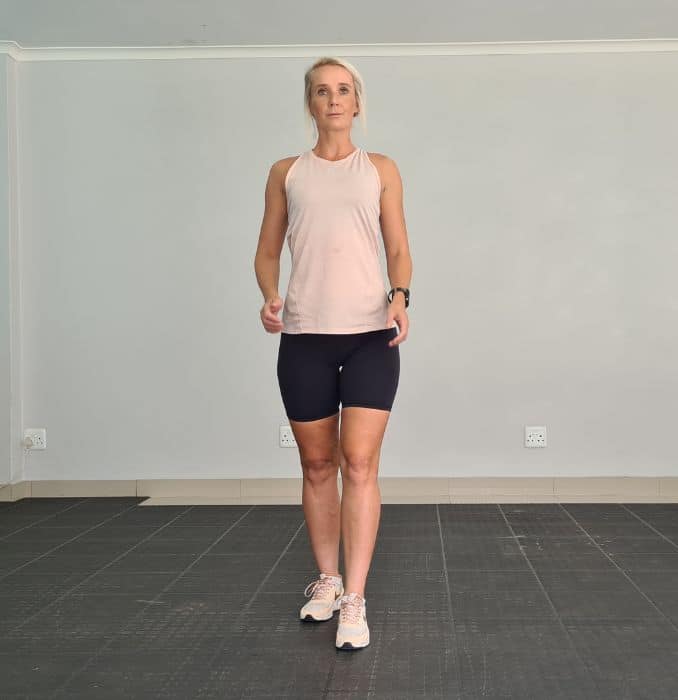 |
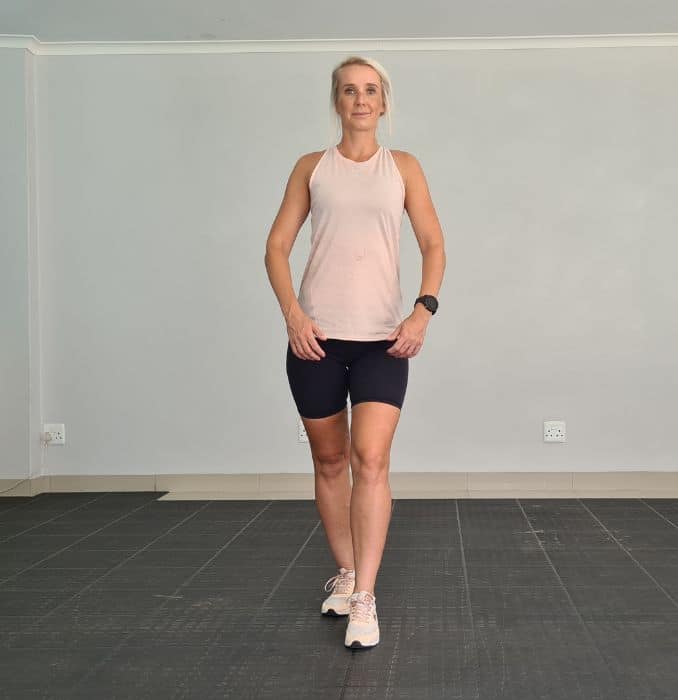 |
2. Side Steps
Begin in an upright standing position with your feet hip-width apart, maintaining good alignment with your head, shoulders, hips, and legs. Engage your core and take a big step to the side with one foot. Then return to the starting position and repeat the movement on the opposite side. Start off with 3 sets of 10 repetitions on each side.
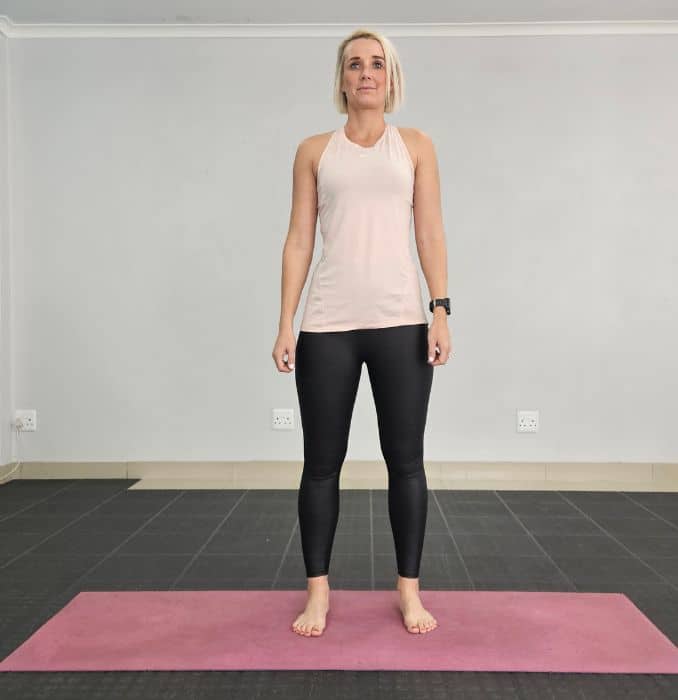 |
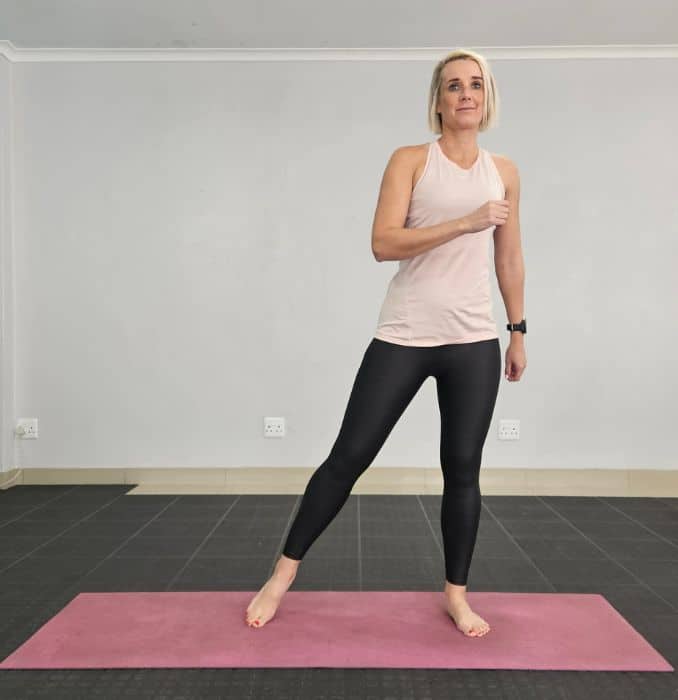 |
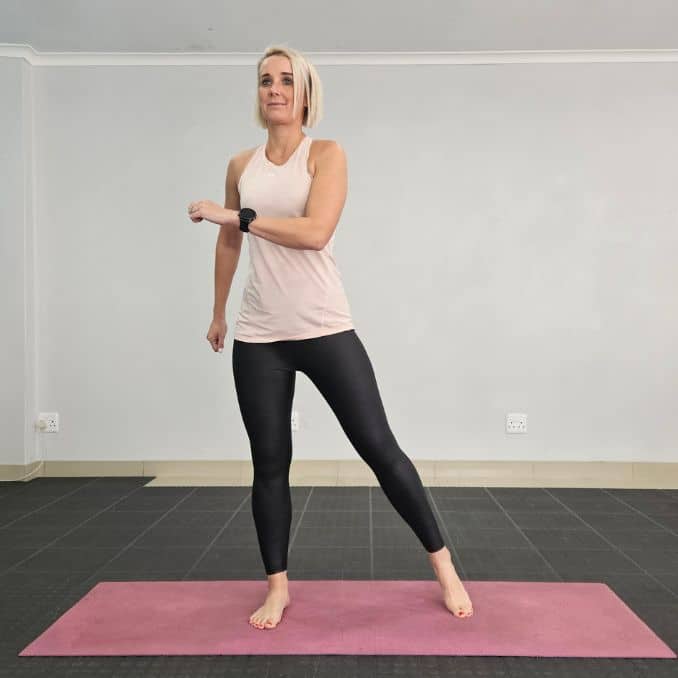 |
3. Marches
Begin in an upright standing position with your feet hip-width apart, maintaining good alignment with your head, shoulders, hips, and legs. Place your hands on your hips. Engage your core and lift one knee up towards your chest, ideally to hip height. Then return to the starting position and repeat the movement on the opposite side. Depending on your comfort level, counter the movement with your opposite arm. Complete for 3 sets of 10 repetitions.
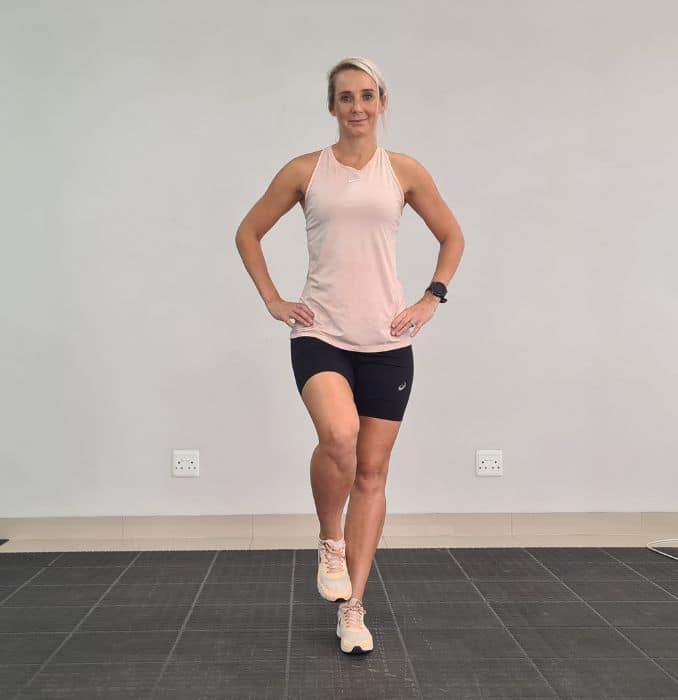 |
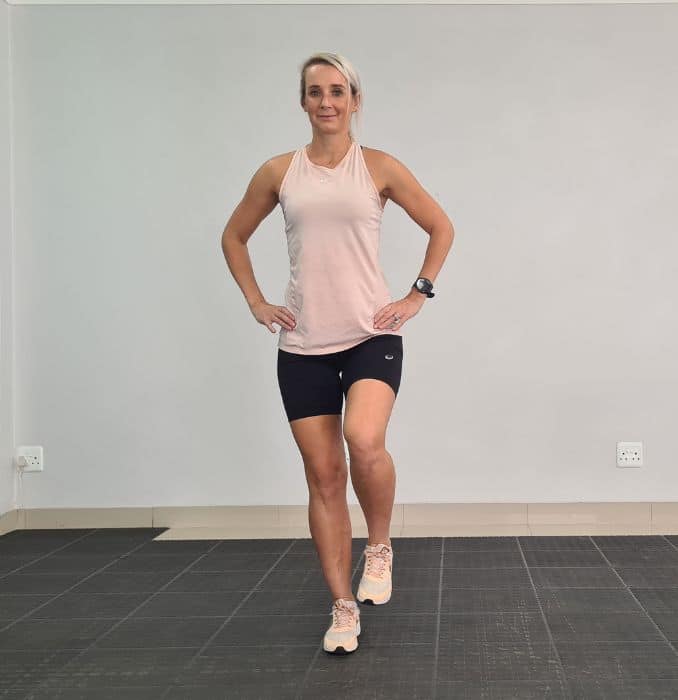 |
4. Arm Raises
Begin in an upright standing position with your feet hip-width apart, maintaining good alignment with your head, shoulders, hips, and legs. Place your arms at your sides and step one foot forward. Engage your core and swing to extend both arms overhead. Then lower your arms to the starting position and repeat the movement. Complete for 10 repetitions.
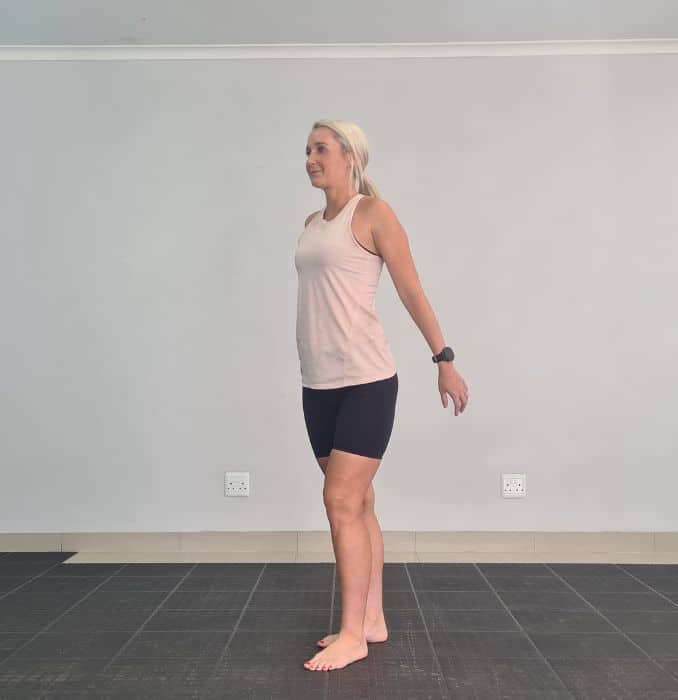 |
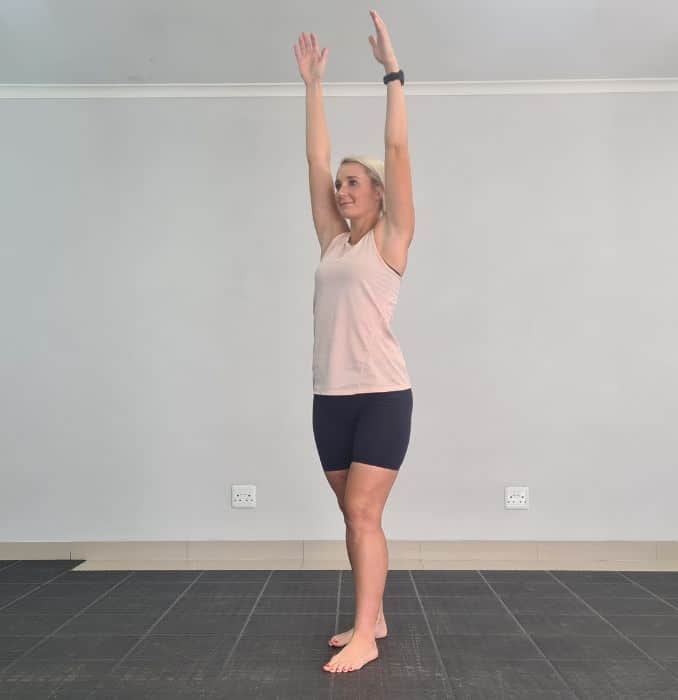 |
Routines
1. Pectoral Stretch
Begin in an upright standing position in front of a wall corner with your feet hip-width apart, maintaining good alignment with your head, shoulders, hips, and legs. Move your feet back to increase the angle of your body. Then slowly lean forward and press your hands against each side of the wall, gently stretching the front of your chest while squeezing your shoulder blades together. Hold the position for several deep belly breaths, in through your nose and out through your mouth. Relax and return to the starting position. Repeat the movement as needed.
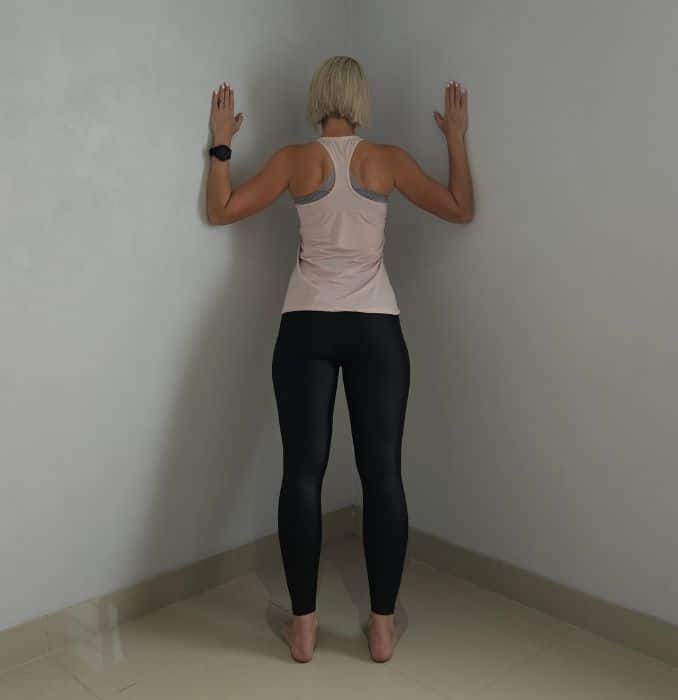
2. Scapula Squeeze
Begin in an upright sitting position on a chair with your knees bent and feet flat on the floor, maintaining good alignment with your head, shoulder, and hips. Then place your hands on your thighs and let your shoulder blades drop naturally. Engage your core and arch your midback as you squeeze your shoulder blades together. Hold the position for several deep belly breaths, in through your nose and out through your mouth. Repeat the movement as needed.
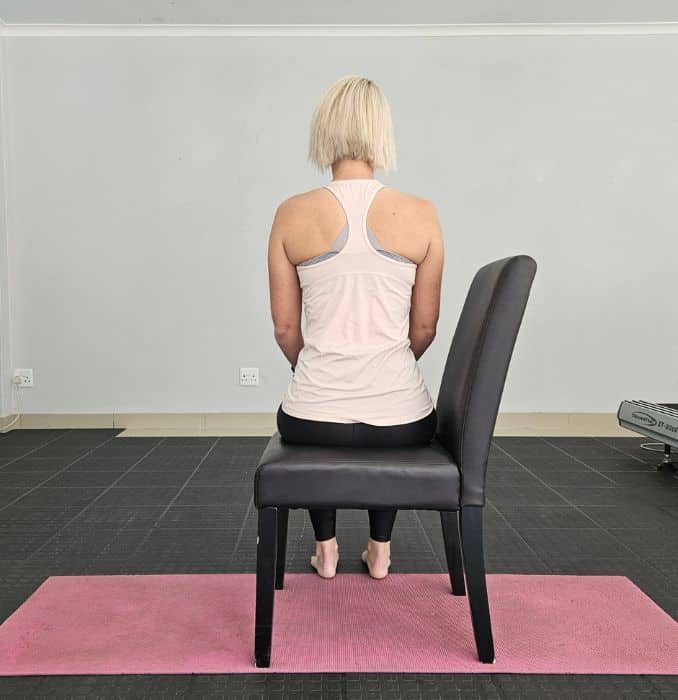 |
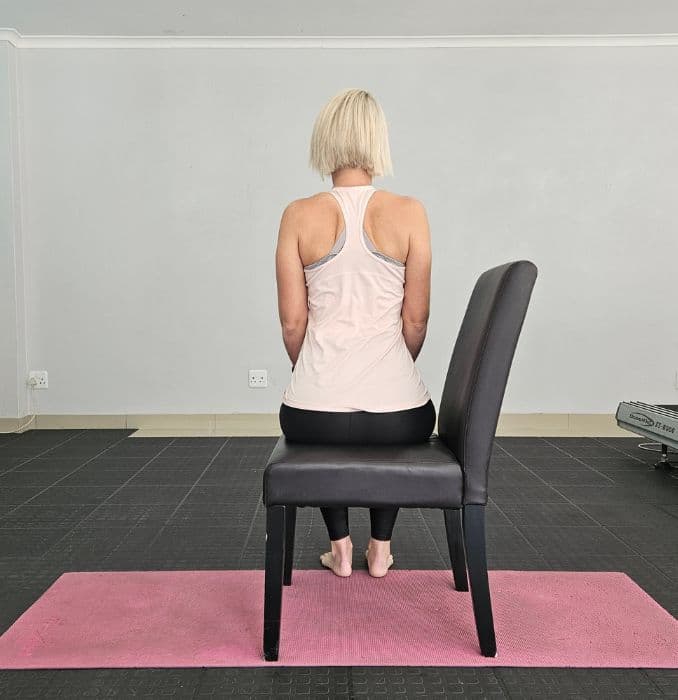 |
3. Chest Press
For this exercise, utilize the dumbbells or anything with weight for added resistance.
Lie on your back on the floor with your knees bent and feet flat on the floor. Hold a dumbbell in each hand. Bend your arms out at your sides to align the dumbbells with your chest. Then tighten your core and extend your arms to press the dumbbells upward. Lower the dumbbells back down to the starting position and repeat the movement.
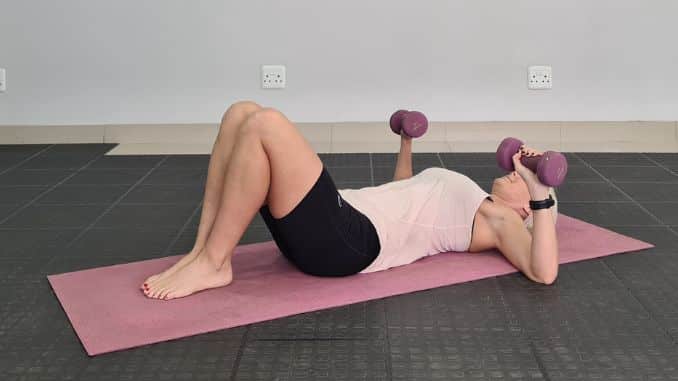 |
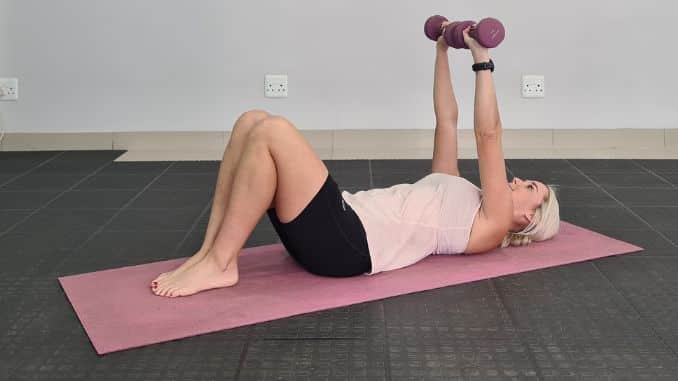 |
4. Bodyweight Chest Fly
Begin in an upright standing position with your feet hip-width apart, maintaining good alignment with your head, shoulders, hips, and legs. Hinge through your hips to bend your upper body forward. Then press your palms together with your fingers pointing toward the floor. Engage your core and open your arms out the sides, ideally up to shoulder- height. Lower your arms back to the starting position and repeat the movement.
Including Bodyweight Chest Flies in your beginner's home workout routine can help strengthen your 230- and improve upper body stability.
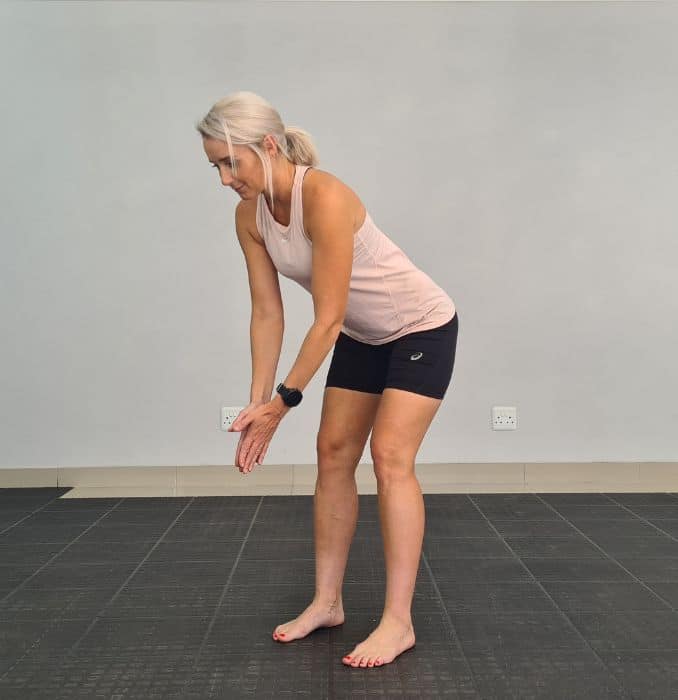 |
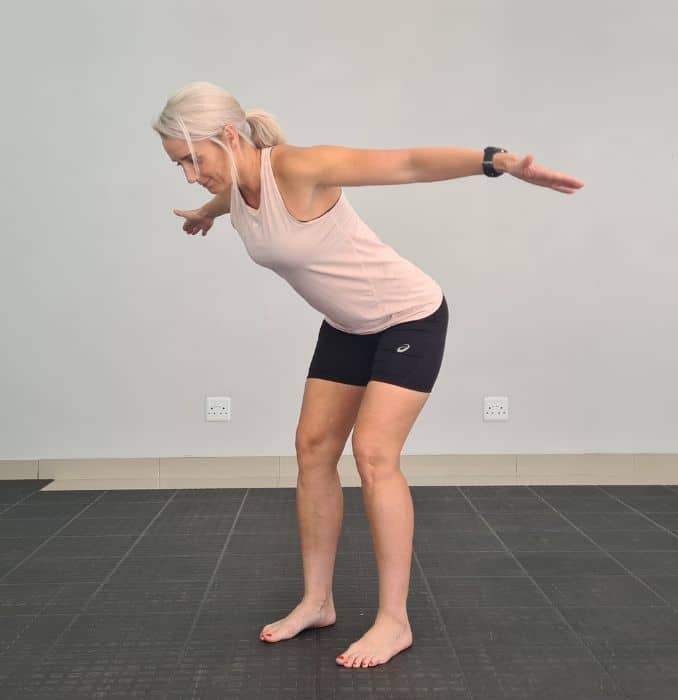 |
Cool Downs
1. Chest Stretch
Begin in an upright standing position with your feet shoulder-width apart, maintaining good alignment with your head, shoulder, hips, and legs. Then engage your core and interlace your fingers behind your back. Arch your back, bringing your gaze upward and lifting your joined hands away from your body. Hold the position for several deep belly breaths through your nose and mouth. Relax and return to the starting position.
Depending on your comfort level, bend your head from side to side to intensify the stretch.
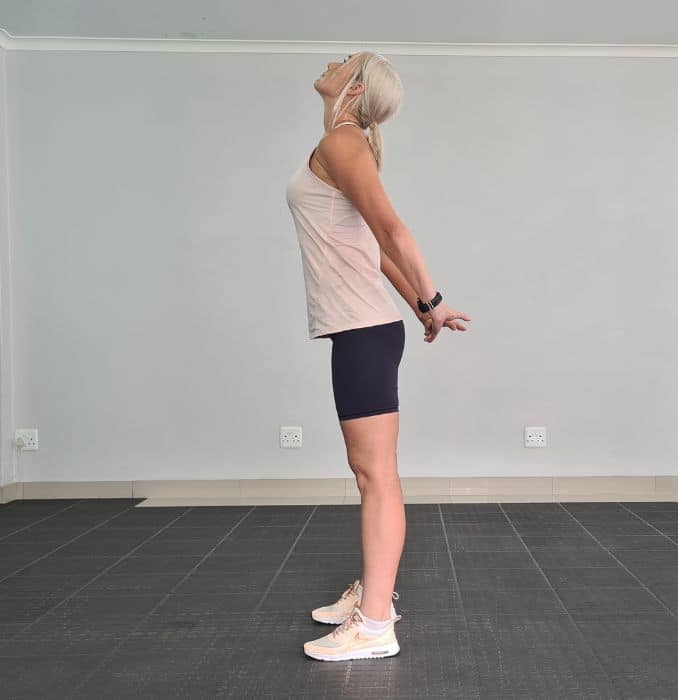
2. Cross Arm Stretch
Begin in an upright standing position with your feet shoulder-width apart, maintaining good alignment with your head, shoulder, hips, and legs. Engage your core. Extend one arm across your chest and use your other hand to slowly push your extended arm towards your body, intensifying the stretch. Hold the position for a couple of seconds. Relax and return to the starting position. Then repeat the movement on the opposite side.
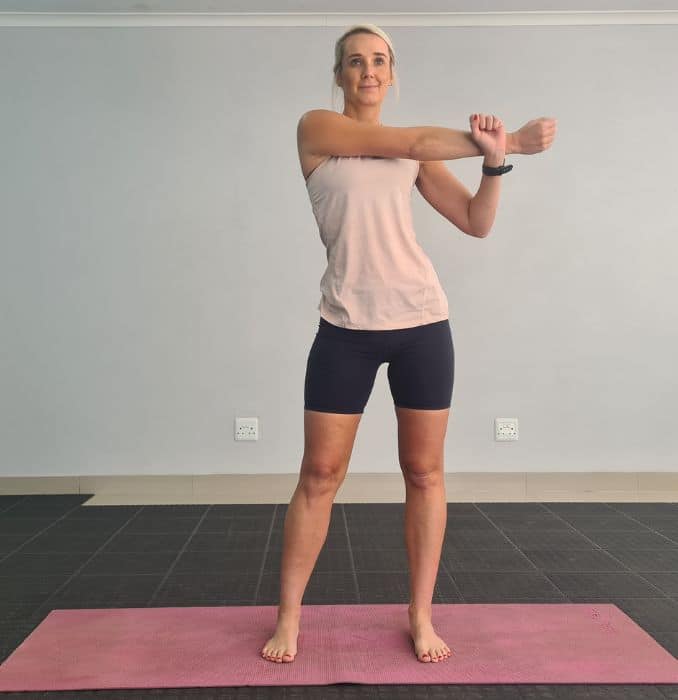
3. Back Stretch
Begin in an upright standing position with your feet shoulder-width apart, maintaining good alignment with your head, shoulders, hips, and legs. Then place your hands on your lower back or upper pelvis area. Engage your core and keep your gaze focused on an unmoving point or object in front of you as you slightly arch your back for a light stretch. Hold this position for several deep belly breaths, in through your nose and out through your mouth. Relax and repeat the movement as needed.
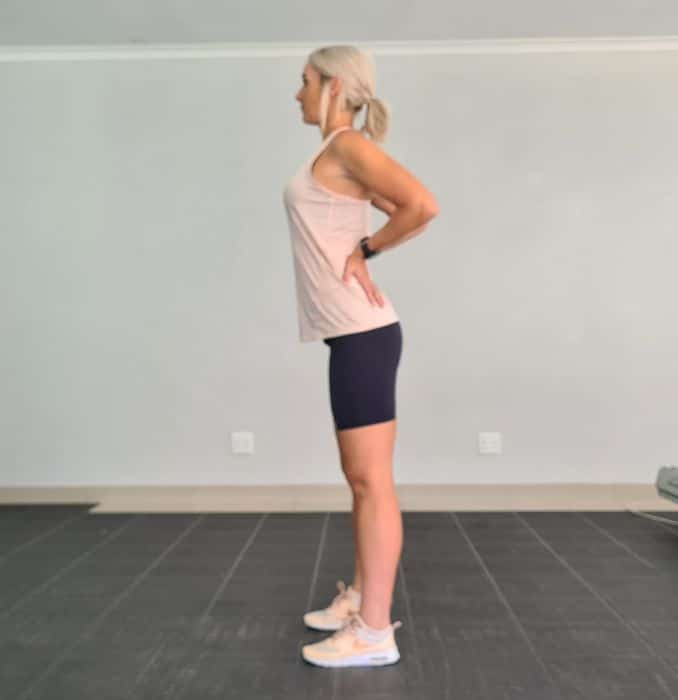
Lifestyle Changes and Self-Care Practices
Making adjustments to daily habits and incorporating self-care practices can significantly impact the experience of living with costochondritis. Practices aimed at reducing stress, like meditation, deep breathing exercises, or yoga, can ease bodily tension and encourage a sense of relaxation. Moreover, maintaining proper posture, avoiding activities that strain the chest area, and ensuring adequate rest and sleep are essential components of self-care for individuals with costochondritis.
Support and Resources for Costochondritis Patients
Navigating the challenges of costochondritis can feel isolating, but it's important to remember that support and resources are available. Additionally, online communities and support networks focused on individuals experiencing costochondritis diagnosis can offer a sense of belonging, shared experiences, and valuable insights into managing the condition. Moreover, seeking guidance from healthcare professionals specializing in musculoskeletal disorders can provide tailored advice and treatment plans to address the specific needs of costochondritis patients.
Maintaining a Healthy Lifestyle Post-Recovery
Even after recovering from costochondritis or an upper respiratory infection, maintaining a healthy lifestyle is essential to prevent recurrence and promote overall well-being. Moreover, prioritizing a balanced diet rich in anti-inflammatory foods, staying physically active through regular exercise, and continuing stress management practices are key components of a healthy lifestyle post-recovery. Staying attuned to the body's signals and adjusting to ensure ongoing chest health and overall wellness is essential.
Conclusion and Encouragement
In conclusion, the journey from struggling with costochondritis to experiencing recovery is a testament to the resilience of the human spirit and the transformative power of holistic healing. By understanding the nature of costochondritis, exploring natural remedies, and incorporating lifestyle adjustments, individuals can take significant strides toward alleviating costochondritis symptoms and achieving a pain-free existence.
Moreover, whether you're embarking on your journey to recovery or seeking to support a loved one dealing with costochondritis, know that there is hope, and with the right tools and support, a fulfilling, pain-free life is within reach.
Unlock the secrets to defeating inflammation! Discover firsthand how Costochondritis was conquered from struggle to recovery in our Master Guide to Inflammation. Check it out today!

